After walking away from them, we had to move to another guesthouse. The Red Piano didn't have any vacancies, so we moved to Bun Seda Angkor Villa, which was one block east. Buntay was also punctual, so we climb in the back of the tuk tuk and set off. The tuk tuk was different from Thailand & Laos though - James & I thought of it as more of a chariot. It was a two-wheeled cart with a roof that was pulled behind Buntay's motorbike. It was a great way to travel, and it kept the sun from roasting us as we moved from one place to the next.
The Angkor Archaeological Park is very dispersed; I don't have the exact figures, but I think there are ruins within a 60 sq. km radius. Neither James nor I had a good understanding of just how large the park or the ruins were.
As we headed for the park, we needed to stop at the ticket booth and purchase a 3-day pass. The pass cost us $40US, which may be the most expensive thing that I purchased all trip. However, every dollar was well worth it. The ruins themselves are inspiring, and there is an indescribable amount of restoration work happening at each one of the temples. I had heard that Angkor Wat was one of the largest tourist attractions in Asia, and that assessment was exact. As we drove toward the park entrance, bus horns blared as the bus loads of Chinese, Korean, and Japanese tourists swerved around us. The environment here was much different from Laos, but the ruins are so impressive that the hordes of tourists didn't detract from our experience.
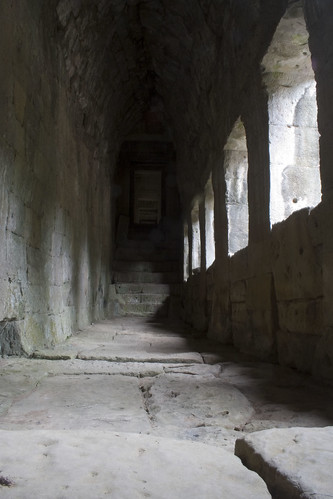
Our first day would be spent exploring to temples - Angkor Thom was first, and then we'd visit Angkor Wat in the afternoon and watch the sunset from its lawns. Angkor Thom contained the famous faces of Cambodia - all of these sculpted faces are part of the Bayon group, which was our first stop. As we approached the site, it started to tower above us. As I got closer to the stone, my eyes diverted from the entire site and focused on some of the walls & stone columns. Each one had figures, pictures, or script carved into the sandstone. As I began to wander through the site, I realized that every wall was covered with some type of carving - there were no 'flat' stones except for on the ground. The Bayon was being restored by a project team from Japan - they had been working for years on the restoration, and had most recently completed the library.
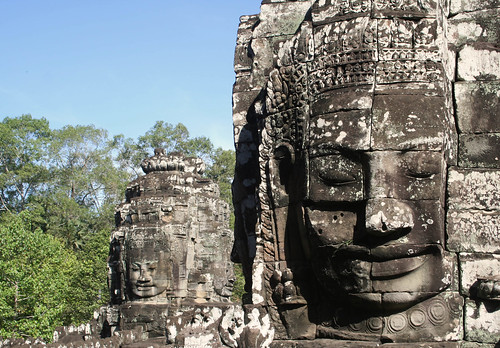
The process was painstakingly detailed. The archaeologists would take photos, draw each stone, and label it before dismantling a wall. After they had exact photos & blueprints of the walls (including the carvings on the faces of the stone), they would begin the work of removing the outer layer. There was another layer beneath the sandstone which provided additional support. This layer was also photographed, blueprinted, and labeled. After this was done, some of the repair work could start. There were rules about how many 'new' stones can be put into the ruins. The 'new' stones can never outnumber the originals, and have to be made from the same type of sandstone. Many of the temples were built on sand, so there had been some shifting over time. In the past, previous teams had tried to restore some of the temples using crude techniques with steel bars and/or concrete. The irony is that these techniques destroyed the original integrity of the stones - the concrete didn't resemble the original carvings in any way, and the stones held together with metal rods had to be drilled. The new accepted method (supported by the government and archaeologists) is to only use the same type of materials, and to remove any 'preventative measures' that had been applied to the temples in the past.
For the number of tourists who were at the Bayon, there were still places in the complex that didn't have anyone. The tour groups (which made up the majority of the people) made a beeline through the complex, which probably explained why there were not people in the lower levels. The faces that make up the upper levels of the temple have hard-to-describe faces; the faces are very peaceful, and they have the slightest resemblance of a smile. We spent about 2.5 hours wandering around the temple, and we took a ton of photos. We stopped for a bit of fresh pineapple & water before moving onwards to the other temples. We spent some more time in & around Angkor Thom, which contains several other temples (although the Bayon faces are one of my favorites). As we walked further away from the Bayon, the crowds started to dissipate.
For the number of tourists who were at the Bayon, there were still places in the complex that didn't have anyone. The tour groups (which made up the majority of the people) made a beeline through the complex, which probably explained why there were not people in the lower levels. The faces that make up the upper levels of the temple have hard-to-describe faces; the faces are very peaceful, and they have the slightest resemblance of a smile. We spent about 2.5 hours wandering around the temple, and we took a ton of photos. We stopped for a bit of fresh pineapple & water before moving onwards to the other temples. We spent some more time in & around Angkor Thom, which contains several other temples (although the Bayon faces are one of my favorites). As we walked further away from the Bayon, the crowds started to dissipate.
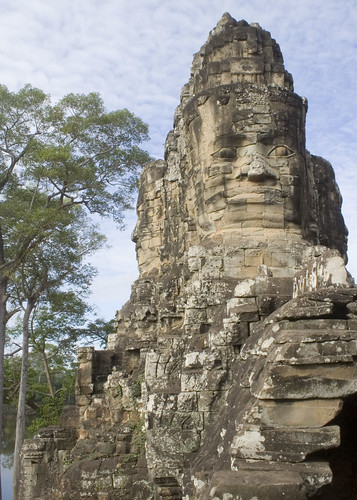 Buntay took us to lunch after a hard morning of temple exploring; we had lunch across the road from Angkor Wat. This was a huge mistake - it's the worst food that I had during my entire trip. And the worst part is that I paid $4.50 for a plate of fried rice. I was shocked at the Cambodia prices after being able to get a plate of more flavorful fried rice for $1 in Laos. I realize that this is all little money to us Americans, but I get used to certain prices when I travel. This occurs when I leave a really inexpensive country to go to a more expensive one - I find myself looking for cheaper food, even if it takes a bit of extra time. Then I need to stop myself and realize that it's only a few dollars, and the time that I'll waste searching for something else is more valuable than $2 or $3.
Buntay took us to lunch after a hard morning of temple exploring; we had lunch across the road from Angkor Wat. This was a huge mistake - it's the worst food that I had during my entire trip. And the worst part is that I paid $4.50 for a plate of fried rice. I was shocked at the Cambodia prices after being able to get a plate of more flavorful fried rice for $1 in Laos. I realize that this is all little money to us Americans, but I get used to certain prices when I travel. This occurs when I leave a really inexpensive country to go to a more expensive one - I find myself looking for cheaper food, even if it takes a bit of extra time. Then I need to stop myself and realize that it's only a few dollars, and the time that I'll waste searching for something else is more valuable than $2 or $3.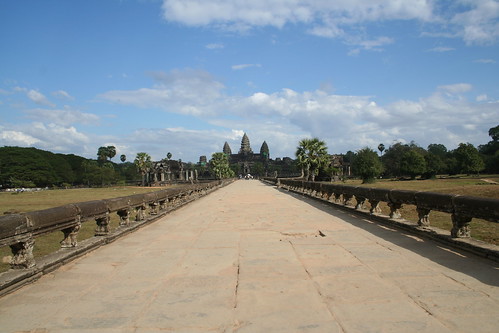
Angkor Wat lives up to its reputation - the complex is enormous. I found myself being humbled before even reaching the main complex. The moat & walkway to the temple are so large that I felt small when I saw it from a distance. I assume this is exactly what the architects of the 12th century had intended. Before I forget - this temple is still standing after 900 years. The majority of it is intact, although some of the reliefs & carvings have begun to wear due to hundreds of years of exposure to the elements. There has always been a lot of restoration, but it's difficult to notice after the sandstone discolors.
The most impressive part of Angkor Wat was the bas-reliefs that lined the four outer walls of the main temple. They depicted several different items; one was a tribute to King Suryavaram II, who was the builder & ruler of the Champa empire when Angkor Wat was built. Another depicted the Churning of the Sea of Milk, which led to the beginning of the universe. A serpent by the name of Vasuki winds himself around Mount Mandara, and agrees to act as the implement to churn the milk. There wasn't a fulcrum, so Vishnu turned himself into a sea turtle and acted as the fulcrum to Mount Mandara. The bas-relief depicts gods grasping one end of the snake and demons holding the other end of the snake, trying to churn the Sea of Milk. The myth must be true, since I'm sitting here in front of my computer on Earth, location: universe. (If I have my Hindu mythology wrong, please leave a comment so that I can correct this information.) We stayed until sunset to watch the sunlight fade from the western face of Angkor Wat. A few hundred other people had the same idea, as there were people all over the approach & front lawns outside of the temple.
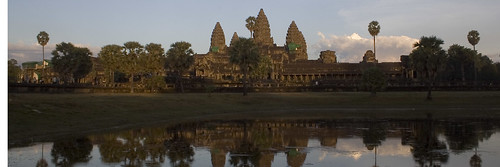
I was determined to get back onto a massage-a-day schedule, so I walked around for 15 minutes until I found one that looked suitable. The cost was $5 for an hour body massage - I REALLY wish these were available at home for the same price. The massages were always an event in cross-cultural communication. After tonight's massage, I was having a conversation with the only woman who could speak a bit of English. All of the sudden there was a stinging sensation coming from my left arm. When I looked over, one of the girls was pulling my arm hair - I have no idea why pull I politely motioned for her to stop. After the massage, we moved onto food & drinks in the Psar Chaa area of Siem Reap.
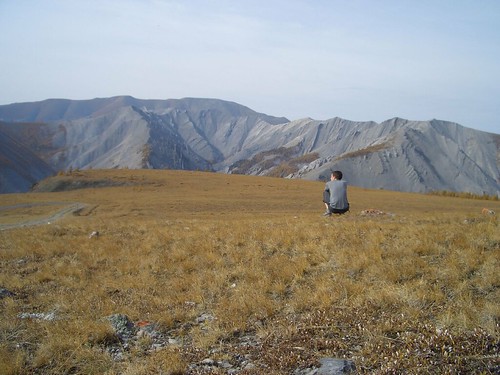
No comments:
Post a Comment